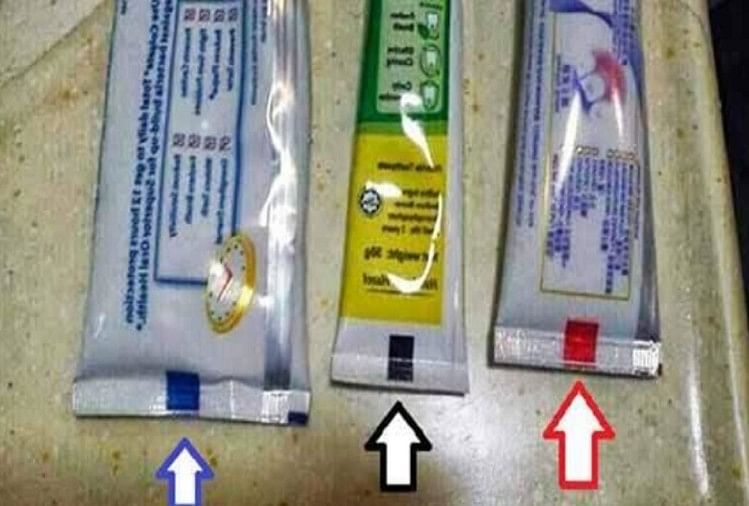
There has been much confusion online as to what the little colored stripes on your toothpaste tube mean. Some believe they indicate what's inside, with green denoting natural ingredients, red showing mixture of natural and chemical components, and black representing all-chemical based content.
There is an Internet theory positing that colored stripes on the bottoms of toothpaste tubes indicate what ingredients they contain; green for all-natural, blue for all natural combined with medicine, red indicating mixtures of natural and chemical components and black indicating pure chemical components.
However, this is far from true: The colors found on the bottoms of toothpaste tubes simply serve as markers during production and shouldn't be read by human eyes; rather they serve to direct machines where to cut, fold, and seal packaging materials.
These marks, also referred to as eye marks, print marks or i-marks, come in various colors such as green, blue, red and black and are used to indicate to robotic sensors which end of a package can be folded or cut during Form, Fill and Seal machine production. You can learn more by watching this video.
Long before, claims on the internet surfaced that small colored bars found at the bottom of toothpaste tubes revealed its ingredients. This code typically appears green, blue, red or black - each representing all-natural, combined with medicine or combination thereof ingredients; green representing all natural as opposed to medicine/chemical combination while blue/red/black could indicate both chemical components or all chemicals respectively.
Actually, color codes on toothpaste don't indicate its contents at all - they are simply printed marks known as eye marks, registration guides or color codes that aid the manufacturing process by informing light sensors where tubes should be cut, folded and sealed.
These colorful markers can be found not only on toothpaste tubes but also milk cartons and cereal boxes. The best way to understand what's inside any toothpaste product is reading its label's ingredients list; any reports claiming that coloured stripes on toothpaste tubes represent some secret code are completely false.
When it comes to toothpaste, there is a range of products available for you. Choose one to whiten teeth, fight cavities or freshen breath - the options can seem overwhelming when browsing oral care aisles! Trying out everything can be confusing when selecting which is the right option.
On social media, there has been a post circulating claiming there is a secret code hidden within the colored stripes found at the bottom of toothpaste tubes. According to this theory, green, blue, red, and black represent different ingredients used - green means all-natural, blue means natural with medicine added, red is both natural and chemical ingredients and black signifies pure chemicals.
Colgate, manufacturer of popular toothpaste brands, denies this claim as it is untrue. Colgate states that the color-coded rectangles are actually print marks called "eye marks", which instruct robot sensors on where packaging needs to be cut, folded or crimped during manufacturing and ensure the correct packaging reaches customers.
An Internet myth holds that the colored markings on toothpaste tubes indicate what ingredients are included, when this is in fact not true; rather they serve as manufacturing process artifacts known as colour marks, printed marks or eye marks to help light beam sensors identify where high-speed machinery should fold or cut packets.
This misconception has been floating around social media for quite some time and advises users that green marks indicate all-natural ingredients while red means natural ingredients mixed with medicines or blue indicates both types. Unfortunately, most toothpaste ingredients don't fit this mold and the rumor doesn't make much sense.
As always, reading labels and consulting your dentist are best methods of making decisions about oral care products.